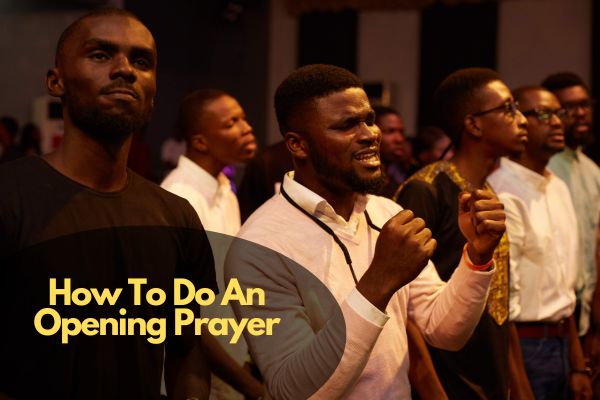Opening prayer stands as a timeless tradition—a sacred invocation that sets the tone for shared moments of reflection, celebration, or deliberation, and this makes the query How to do an opening prayer? quite essential. Whether in religious congregations, educational assemblies, or social events, the art of doing an opening prayer requires a delicate blend of reverence, intention, and inclusivity.
In this guide, we embark on an exploration of the nuances that transform a simple prayer into a meaningful and impactful opening, creating a spiritual or contemplative atmosphere that resonates with participants.
Contents
How To Do An Opening Prayer
In diverse gatherings and communal settings, an opening prayer serves as a powerful ritual, establishing a spiritual or contemplative atmosphere. Whether in religious ceremonies, social events, or educational assemblies, the art of performing an opening prayer involves more than just reciting words—it is about fostering unity, intention, and connection.
This guide navigates through the essential elements of crafting and delivering an opening prayer that resonates with participants, setting the tone for a meaningful and cohesive experience.
1. Understanding the Purpose
Before embarking on crafting an opening prayer, it’s crucial to understand its purpose. An opening prayer serves as an invocation, inviting a collective focus, setting a respectful tone, and acknowledging a higher power. Whether the gathering is formal or informal, the purpose guides the language and sentiments embedded in the prayer.
2. Tailoring for the Audience
Consider the diversity of your audience. A well-crafted opening prayer should be inclusive, acknowledging and respecting the beliefs, backgrounds, and perspectives of all participants. Use language that is universally respectful and considerate, avoiding exclusivity and fostering a sense of unity.
3. Begin with Gratitude
Expressing gratitude is a universal theme that resonates across various beliefs. Commence the prayer by acknowledging the collective blessings, the opportunity to gather, and the shared purpose of the event. Gratitude sets a positive and appreciative tone for the rest of the proceedings.
4. Centering Intentions
An effective opening prayer centre intends, to align participants with a shared purpose or theme. Whether it’s seeking wisdom, unity, or a collective understanding, articulate the intentions clearly. This helps channel the collective energy toward a common goal, fostering a sense of purpose.
5. Use Reverent Language
Craft the language of the prayer with reverence and respect. Choose words that evoke a sense of sacredness without being overly formal. The tone should resonate with the atmosphere of the gathering, whether it’s solemn, celebratory, or reflective.
6. Consider Silence
In some settings, incorporating a moment of silence within the opening prayer allows participants to individually connect with their thoughts, beliefs, or higher power. Silence can be a powerful and inclusive element that accommodates diverse spiritual practices.
7. Practice Delivery
Practice the delivery of the opening prayer to ensure a composed and authentic presentation. Consider the pacing, modulation, and clarity of your voice. Confidence in delivery enhances the impact of the prayer, allowing participants to engage more fully in the moment.
8. Conclude
Wrap up the opening prayer with a unifying sentiment. Emphasize the collective aspect of the gathering, expressing a shared purpose or intention. Concluding with unity reinforces the sense of community and togetherness.
9. Reflect and Evaluate
After delivering the opening prayer, take a moment to reflect on its impact. Consider feedback from participants and evaluate how well the prayer aligned with the goals of the gathering. Continuous reflection allows for refinement and improvement in future occasions.
In essence, the art of doing an opening prayer transcends religious or cultural boundaries—it is a universal practice that cultivates a sense of reverence, unity, and purpose. By embracing these guidelines, one can master the craft of delivering an opening prayer that resonates with the hearts and minds of diverse participants, fostering a collective experience that transcends individual beliefs.
Conclusion
As we conclude this guide on opening prayer, we recognize the profound role it plays in fostering unity and spiritual connection. The art of crafting an opening prayer is not merely a ritual but a deliberate act of creating a sacred space for collective introspection.
Whether spoken aloud or held in silent reverence, a well-executed opening prayer has the power to transcend individual differences, bringing participants together in a shared moment of mindfulness. May this guide empower you to master the art of the opening prayer, allowing each communal gathering to commence with grace, intention, and a spirit of unity.








